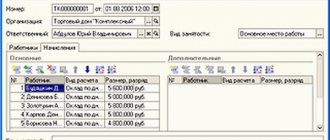Pre-trial procedure for collecting wages
The first and easiest procedure for collecting wages is pre-trial. In this case, this procedure provides two possibilities:
- Agreement of the parties. The parties to the labor relationship enter into a written agreement between themselves and implement it voluntarily. This procedure is good for those situations where the parties do not conflict and are ready to conduct negotiations aimed at results;
- Contacting the Prosecutor's Office and the Labor Inspectorate. The employer, so to speak, is forced to fulfill its obligations by supervisory authorities. This procedure is suitable in cases where the employee does not have any problems with documents. It will be enough to send an application to the Labor Inspectorate or the Prosecutor's Office (it is worth noting that the Prosecutor's Office often forwards applications to the same Labor Inspectorate only if there is no question of criminal liability for non-payment of wages, see the link for more details). There, under the threat of penalties, the inspector will explain to the employer all the grounds for repaying the debt in pre-trial order.
USEFUL: watch the VIDEO with advice from a lawyer on labor matters and find out how to win a dispute with your employer, write your question in the comments of the video and the lawyer will answer you today
Payment deadline
The deduction of funds from the income of the debtor employee begins from the date of receipt of the writ of execution. That is, Stanislav will receive less money in his next salary.
If the bailiffs indicated the retention period in the writ of execution, the accountant needs to transfer the amount established in it at the next salary payment. Typically, the deadline is set for small payments that the debtor pays off at a time.
When the collection period is not specified, the accountant has three working days from the date of payment of the employee’s salary to withhold the debt and transfer the money to the collector.
Part of Stas's salary will be spent on paying off debts until his obligations are fulfilled.
Court order to collect wages
Is it possible to recover wages in writ proceedings? The second way to collect wage arrears is to send an application for the issuance of a court order with the relevant documents attached and receive the order itself, which in itself is a writ of execution. This procedure is simple and is implemented under certain circumstances.
It is especially worth noting the fact that an order to collect wages can be issued only if there is documentary evidence that the employer acknowledges the debt: this could be some kind of certificate from the accounting department, a letter of guarantee, or the like.
Advantages of a court order:
- issued quickly enough;
- the applicant is exempt from proving the circumstances;
- can be sent directly to the bank of the debtor organization.
What is the maximum for retention
Several penalties of different priority
In general, up to 50% of the salary can be withheld according to executive documents (Article 138 of the Labor Code of the Russian Federation and Article of Law No. 229-FZ). But there are five situations when you can withhold up to 70% of your earnings (Article 138 of the Labor Code of the Russian Federation):
- Serving correctional labor.
- Collection of alimony for minor children;
- Compensation for harm caused to the health of another person;
- Compensation for damage to persons who suffered damage due to the death of the breadwinner;
- Compensation for damage caused by a crime.
If several enforcement documents have been received for one employee, including from “preferential” categories, we are guided by the rule of priority: first we satisfy the requirements of the first priority, then the second, and so on (Article 111 of Law No. 229-FZ).
Vasily, an employee of Leader LLC, received two writs of execution. One demands the recovery of a third of earnings as alimony for two children, and the second - half as arrears for housing and communal services.
We start with the first priority payments: the accountant retains a third of the earnings and directs this amount to pay alimony. The requirement has been met, but the limit has not yet been selected, which means that the requirement of the second stage can be satisfied.
The requirement of the second stage - debt for housing and communal services - is satisfied from the unspent limit, and this is ⅙ of earnings: ½ -⅓ = ⅙.
The accounting department will keep the money every month until the entire debt is paid to the utility supplier - or until the collection of alimony stops (Clause 2 of Article 99 of Law No. 229-FZ).
Alimony for children and adults
Alimony can be established not only for minor children, but also for the maintenance of parents, brothers, sisters, and ex-spouse (Article , , Family Code of the Russian Federation). It is easy to distinguish such alimony: they are always set not as a percentage of earnings, but as a fixed amount.
The nuance is that all alimony payments are in the first stage. But alimony for minor children can be collected within 70% of earnings (Article 138 of the Labor Code of the Russian Federation, paragraph 3 of Article No. 229-FZ). And alimony for parents and former spouses is collected within 50% of the salary. This causes problems if both types of alimony must be withheld from the employee at the same time.
If the collected amount is not enough to satisfy all claimants of one queue, it is distributed in proportion to the amount due to each of them, specified in the executive document (clause 3 of Article 111 of Law No. 229-FZ). This means that when collecting two types of alimony, you must first withhold half of the earnings and distribute it between children and adults, since adult recipients of alimony cannot claim an amount of earnings beyond 50%. And then once again make a deduction within 70% and send everything collected to the children.
But since alimony for adults is always set in a fixed amount, and for children most often as a percentage of earnings, then before deduction begins, both requirements must be brought to a common denominator - calculate the amount for each of the children this month, taking into account earnings and the share of alimony.
Ivan Grigorievich has three writs of execution for the collection of alimony: for his son in the amount of ⅙ of earnings, for his daughter in the amount of ¼ of earnings and for his ex-wife in the amount of 5,000 rubles. monthly. The employee's salary is RUB 20,000, and he is entitled to a standard deduction for both children. Let's calculate deductions.
First, let's determine the basis for withholding: money is withheld from the amount remaining after paying personal income tax (clause 1, article 99 of Law No. 229-FZ). In our case, the base will be 17,764 rubles. (20000 − (20000 − 1400 × 2) × 13%).
Now let's start the calculation.
- Let's determine the fixed amounts that are due to each of the claimants: spouse - 5,000 rubles, daughter - 4,441 rubles. (17,764 × 1/4), son - 2960.67 rubles. (17764 × 1/6).
- The total amount of deduction is RUB 12,401.67. (5,000 + 4,441 + 2,960.67), which is more than half of earnings (17,764 × 50% = 8882).
- We will retain half of the earnings (RUB 8,882) and distribute this amount among all three claimants in proportion to their demands:
- spouse's share: (8,882 / (5,000 + 4,441 + 2,960.67)) × 5,000 = RUB 3,580.97;
- daughter's share: (8,882 / (5,000 + 4,441 + 2,960.67)) × 4,441 = 3,180.62 rubles;
- son's share: 8,882 / (5,000 + 4,441 + 2,960.67)) × 2,960.67 = 2,120.41 rubles.
- Since the children received less than the amount that was determined in the first step, further deduction is made within 70% of earnings, i.e. another 2,100.64 rubles are withheld. ((4,441 − 3,180.62) + (2,960.67 − 2,120.41)) of the possible additional withholding of 3,552.8 rubles. (17,764 × 70% − 8882). This money is sent only to children.
In total, the spouse will receive 3,580.97 rubles, the daughter 4,441 rubles, the son 2,690.67 rubles. And the employee is due 6,951.36 rubles for payment. And at the same time, he will have arrears of alimony in favor of his wife in the amount of 1,419.03 rubles.
If the amount withheld within 70% of earnings was not enough to fully pay the children, then the corresponding amount would also be divided between them in proportion to their requirements.
Limits and fees for transferring amounts to the collector
Sometimes the employee is also charged a fee for transferring money in favor of the creditor: bank and postal commissions (clause 3 of Article No. 229-FZ). Keep them within limits or beyond?
It is impossible to collect these amounts beyond the limits (Article 138 of the Labor Code of the Russian Federation). This means that if the employee does not agree to voluntarily compensate for the cost of the transfer (for example, to apply for voluntary deduction from salary), then the accountant will have to reduce the amount of recovery under the writ of execution. As a result, the employee will accrue a debt on the cost of the transfer under the writ of execution - it will need to be withheld from subsequent payments.
How is wages collected in court?
The most difficult way to collect wages is through the courts. The first thing you will need to do is file a claim for recovery of wages. Further in the legal process, you need to pay attention to many nuances. First of all, if the opposing party appears in court, you need to carefully study the defense to garnishment of wages that the opponent will present. From it you can form a vision of the other side of this whole situation and refine your position. But let's go in order.
Claim in court for recovery of wages
The statement of claim for recovery of wages must set out in detail all the circumstances that you base the claim on. So, it must be described for what period and what payments the employer owes you (the calculation must be attached), it must also indicate who you worked for, what your job responsibilities were.
If in the employee-employer relationship you do not have enough documentary evidence to confirm your work activity, then it would not be a bad idea to invite witnesses. They can also be indicated in the statement of claim. Then the statement of claim will need to indicate a requirement to establish the fact of an employment relationship.
Features of collecting wages through the court
- Government duty. One of the features is the exemption of the employee from paying state fees when filing an application with the court. By not paying the state duty on a claim for recovery of wages, the legislator protects the rights of the employee. The logic is already at work here: how will an employee pay state duty if he has not been paid a salary (his livelihood, after all).
- Jurisdiction of cases of wage recovery. The jurisdiction of labor disputes regarding the collection of wages does not indicate any specifics - here the employee has the right to choose. The legislator in the Civil Procedural Legislation indicates that an employee has the right to bring claims for the restoration of his violated rights both at the location of the defendant and at his place of residence, or even at the place of performance of labor duties (if it is determined by the Agreement).
- Deadline for collecting wages. The deadline for collecting wages, which does not coincide with the general statute of limitations. The period for resolving a labor dispute arising in the course of employment is three months. The period for challenging dismissal is one month. The dispute over the recovery of wages was recently extended and lasts for one calendar year. By the way, it is also important that the employer has the same one-year period to collect wages from the employee if the latter caused damage to the employer.
Requirements in a claim for recovery of wages
Separately, I would like to point out that in addition to unpaid wages, an employee has the right to indicate a number of demands in his statement of claim:
- compensation for unused vacation;
- unpaid bonuses;
- benefits and allowances;
- compensation for delayed wages;
- compensation for moral damage.
Package of documents attached to the statement of claim
In addition to a copy of the Claim for the parties to the case, you need to attach as many documents as possible proving both the fact of the employment relationship and the fact of arrears in wages - so the package of applications here is quite unique. Thus, the documents for collecting wages are often submitted as follows: an order for employment, an employment contract, a work record book, a salary sheet and others.
The procedure for executing a court decision
So, you achieved your goal and won a sous. The decision came into force. Here the question arises of how to implement the court decision. There are several options:
- submit a writ of execution to the bailiff service;
- submit a writ of execution directly to the debtor for voluntary execution;
- submit a writ of execution to the bank of the debtor organization.
Legal basis
In accordance with Art. 392 of the Labor Code of the Russian Federation, the statute of limitations for collecting wages is a certain period, which from mid-2021 is equal to one year (until this point, the general rule of a three-month period for labor disputes was in effect). Thus, in such relationships, labor law norms apply, and the courts, when considering applications, are guided by the general rules established by the Civil Code.
In particular, according to the provisions of the Civil Code, if the statute of limitations has expired, but the defendant has not applied to the court with an application to skip it, the court will consider the case and make a decision.
What to do if you miss it
The Labor Code of the Russian Federation establishes that the statute of limitations for arrears of wages in exceptional cases is allowed to be restored (extended). But to do this, you will need to prove the presence of good reasons: the legislator associates the possibility of restoration with their presence. And the final decision remains with the court. Please note that there is no provision for a separate appeal of the court’s decision to refuse reinstatement to a higher authority, that is, it can only be appealed against the main court decision.
What does the legislation guarantee regarding wages?
Labor legislation protects the rights of employees to receive wages in full and on time (Article 130 of the Labor Code of the Russian Federation):
- The minimum wage has been established (Article 133 of the Labor Code of the Russian Federation).
- Salaries are paid at least every half month (Article 136 of the Labor Code of the Russian Federation).
- The employer's liability for violation of labor legislation has been established (Article 142 of the Labor Code of the Russian Federation and Article 5.27 of the Code of Administrative Offenses of the Russian Federation).
In case of violations, the employee has the right to file a pre-trial claim with the company for non-payment of wages or immediately contact the regulatory authorities and the court. And also suspend work if the delay exceeds 15 days.
If salaries are not paid on time, employees must be paid compensation for each day of delay in the amount of at least 1/150 of the Central Bank discount rate (Article 236 of the Labor Code of the Russian Federation).
IMPORTANT!
Personal income tax is not withheld from compensation for delayed wages.







